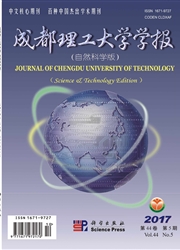

 中文摘要:
中文摘要:
岩石薄片、粘土矿物、储层物性资料综合分析结果表明,莱州湾凹陷古近系砂岩储层的岩石类型为长石砂岩和岩屑长石砂岩,砂岩储层处于早成岩阶段B期至中成岩阶段B期,而现存的有效孔隙为原生孔隙和次生孔隙的混合成岩孔隙,孔隙类型以扩大粒间孔隙为主,被溶蚀的组分主要是长石颗粒和粒间碳酸盐胶结物。埋藏深度大干2.2km的SQs4L,SQs4u和SQs3m砂岩储层次生孔隙所占比例较高,次生孔隙成为重要的油气储集空间。这一认识指明了莱州湾凹陷古近系深部砂岩储层具有极大的勘探潜力。
 英文摘要:
英文摘要:
Based on the data of rock slices, clay minerals, and porosity-permeability of the sandstone reservoir, this paper clarifies the characteristics of the Paleogene sandstone reservoir of the Laizhouwan sag. The sandstones mainly consist of arkose and lithic arkose. The reservoir is in the diagenesis stage of the B period of the early diagenesis stage to that of the middle diagenesis stage. The pores of the sandstone consist of primary pores and secondary pores. The main type of the pores is enlarged intergranular pore and the dissolved mineral compositions are mainly feldspar and intergrain carbonate cements. The sandstone reservoirs of SQs4L, SQs4u and SQs3m, which are buried more than 2200 m depth, hold a large of secondary pores that become the important hydrocarbon pore volume.
 同期刊论文项目
同期刊论文项目
 同项目期刊论文
同项目期刊论文
 期刊信息
期刊信息
